Keep it lega
Page 44
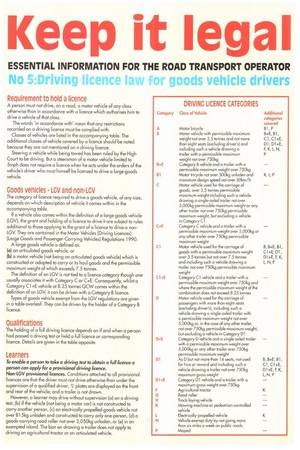
Page 45
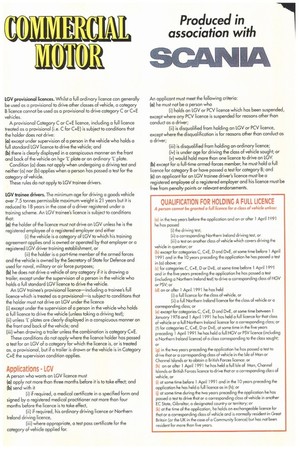
Page 46
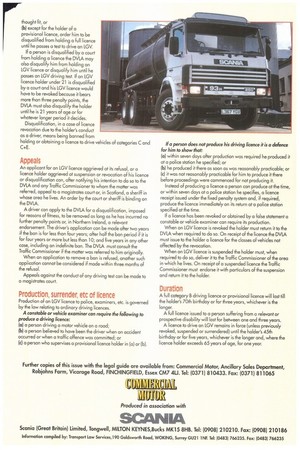
Page 47
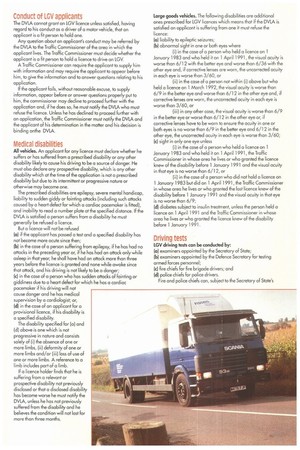
Page 48
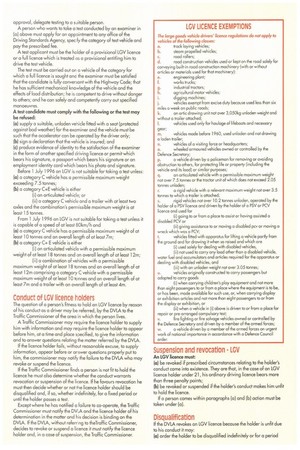
If you've noticed an error in this article please click here to report it so we can fix it.
ESSENTIAL INFORMATION FOR THE ROAD TRANSPORT OPERATOR
No 5:Driving licence law for goods vehicle drivers
Requirement to hold a licence
A person must not drive, on a road, a motor vehicle of any class otherwise than in accordance with a licence which authorises him to drive a vehicle of that class.
The words 'in accordance with' mean that any restrictions recorded on a driving licence must be complied with.
Classes of vehicles are listed in the accompanying table. The additional classes of vehicle covered by a licence should be noted because they are not mentioned on a driving licence.
Steering a vehicle while being towed has been ruled by the High Court to be driving. But a steersman of a motor vehicle limited to 5mph does not require a licence when he acts under the orders of the vehicle's driver who must himself be licensed to drive a large goods vehicle.
Goods vehicles• LGV and non-LGV
The category of licence required to drive a goods vehicle, of any size, depends on which description of vehicle it comes within in the accompanying table.
If a vehicle also comes within the definition of a large goods vehicle (LGV), the grant and holding of a licence to drive it are subject to rules additional to those applying to the grant of a licence to drive o nonLGV. They are contained in the Motor Vehicles (Driving Licences) (Large Goods and Passenger-Carrying Vehicles) Regulations I 990.
A large goods vehicle is defined as:
(a) an articulated goods vehicle, or (b) a motor vehicle (not being an articulated goods vehicle) which is constructed or adapted to carry or to haul goods and the permissible maximum weight of which exceeds 7.5 tonnes.
The definition of an LGV is not tied to a licence category though one usually associates it with Category C or C+E. Consequently, whilst a Category Cl +E vehicle at 8.25 tonnes GCW comes within the definition of an LGV, it can be driven with a Category B licence.
Types of goods vehicle exempt from the LGV regulations are given in a table overleaf. They con be driven by the holder of a Category B licence.
Qualifications
The holding of a full driving licence depends on if and when a person had passed a driving test or held a full licence or corresponding licence. Details are given in the table opposite.
Learners
To enable a person to take a driving test to obtain a full licence a person can apply for a provisional driving licence.
Non-LGV provisional licences. Conditions attached to all provisional licences are that the driver must not drive otherwise than under the supervision or a qualified driver; plates are displayed on the front and rear of the vehicle; and a trailer is not drawn.
However, a learner may drive without supervision (a) on a driving test, (b) if the vehicle (not being a motor car) is not constructed to carry another person, (c) an electrically propelled goods vehicle not over 815kg unladen and constructed to carry only one person, (d) a goods-carrying road roller not over 3,050kg unladen, or (e) in an exempted island. The ban on drawing a trailer does not apply to driving an agricultural tractor or an articulated vehicle. LGV provisional licences. Whilst a full ordinary licence can generally be used as a provisional to drive other classes of vehicle, a category B licence cannot be used as a provisional to drive category C or C+E vehicles.
A provisional Category C or C+E licence, including a full licence treated as a provisional (i.e. C for C+E) is subject to conditions that the holder does not drive:
(a) except under supervision of a person in the vehicle who holds a full standard LGV licence to drive the vehicle; and (b) there is clearly displayed in a conspicuous manner on the front and back of the vehicle an hgv 'L' plate or an ordinary 'L' plate.
Condition (a) does not apply when undergoing a driving test and neither (a) nor (b) applies when a person has passed a test for the category of vehicle.
These rules do not apply to LGV trainee drivers.
LGV trainee drivers. The minimum age For driving a goods vehicle over 7.5 tonnes permissible maximum weight is 21 years but it is reduced to 18 years in the case of a driver registered under a training scheme. An LGV trainee's licence is subject to conditions that: (a) the holder of the licence must not drive an LGV unless Fie is the registered employee of a registered employer and either
(i) the vehicle is a category of LGV to which his training agreement applies and is owned or operated by that employer or a registered LGV driver training establishment, or (ii) the holder is a part-time member of the armed forces and the vehicle is owned by the Secretary of State for Defence and used for naval, military or air force purposes;
(13) he does not drive a vehicle of any category if it is drawing a trailer, except under the supervision of a person in the vehicle who holds a Full standard LGV licence to drive the vehicle.
An LGV trainee's provisional licence—including a trainee's full licence which is treated as a provisional—is subject to conditions that the holder must not drive an LGV under the licence
(i) except under the supervision of a person in the vehicle who holds a full licence to drive the vehicle (unless taking a driving test);
(ii) unless `L' plates are clearly displayed in a conspicuous manner on the front and back of the vehicle; and
(iii) when drawing a trailer unless the combination is category C+E.
These conditions do not apply where the licence holder has passed a test for an LGV of a category for which the licence is, or is treated as, a provisional, but if a trailer is drawn or the vehicle is in Category C+E the supervision condition applies.
Applications LGV
A person who wants an LGV licence must
(a) apply not more than three months before it is to take effect; and (6) send with it
(i) if required, a medical certificate in a specified form and signed by a registered medical practitioner not more than four months before the licence is to take effect, (ii) if required, his ordinary driving licence or Northern Ireland driving licence, (iii) where appropriate, a test pass certificate for the category of vehicle applied For.
An applicant must meet the following criteria: (a) he must not be a person who
(i) holds an LGV or PCV licence which has been suspended, except where any PCV licence is suspended for reasons other than conduct as a driver; (ii) is disqualified from holding an LGV or PCV licence, except where the disqualification is for reasons other than conduct as a driver; (iii) is disqualified from holding an ordinary licence; (iv) is under age for driving the class of vehicle sought; or
(v) would hold more than one licence to drive an LGV. (a) except for a full-time armed-forces member, he must hold a full licence for category B or have passed a test for category B; and
(c) an applicant for an LGV trainee driver's licence must be a registered employee of a registered employer and his licence must be free from penalty points or relevant endorsements.
rilir-thought fit, or
lb) except for the holder of a provisional licence, order him to be disqualified from holding a full licence until he passes a test to drive an LGV. If a person is disqualified by a court from holding a licence the DVLA may also disqualify him from holding an LGV licence or disqualify him until he passes an LGV driving test. If an LGV licence holder under 21 is disqualified by a court and his LGV licence would have to be revoked because it bears more than three penalty points, the DVLA must also disqualify the holder until he is 21 years of age or for whatever longer period it decides.
Disqualification, in a case of licence revocation due to the holder's conduct as a driver, means being banned from holding or obtaining a licence to drive vehicles of categories C and C+E.
Appeals
An applicant for an LGV licence aggrieved at its refusal, or a licence holder aggrieved at suspension or revocation of his licence or disqualification can, after notifying his intention to do so to the DVLA and any Traffic Commissioner to whom the matter was referred, appeal to a magistrates court or, in Scotland, a sheriff in whose area he lives. An order by the court or sheriff is binding on the DVLA.
A driver can apply to the DVLA for a disqualification, imposed for reasons of fitness, to be removed as long as he has incurred no further penalty points or, in Northern Ireland, a relevant endorsement. The driver's application can be made after two years if the ban is for less than four years; after half the ban period if it is for four years or more but less than 10; and five years in any other case, including an indefinite ban. The DVLA must consult the Traffic Commissioner if the matter was referred to him originally.
When an application to remove a ban is refused, another such application cannot be considered if made within three months of the refusal.
Appeals against the conduct of any driving test can be made to a magistrates court,
Production, surrender, etc of licence
Production of an LGV licence to police, examiners, etc. is governed by the law relating to ordinary driving licences.
A constable or vehicle examiner can require the following to produce a driving licence: (a) a person driving a motor vehicle on a road; (b) a person believed to have been the driver when an accident occurred or when a traffic offence was committed; or (c) a person who supervises a provisional licence holder in (a) or (b). If a person does not produce his driving licence it is a defence for him to show that: (a) within seven days after production was required he produced it at a police station he specified; or (b) he produced it there as soon as was reasonably practicable; or (c) it was not reasonably practicable for him to produce it there before proceedings were commenced for not producing it.
Instead of producing a licence a person can produce at the time, or within seven days at a police station he specifies, a licence receipt issued under the fixed penalty system and, if required, produce the licence immediately on its return at a police station specified at the time.
If a licence has been revoked or obtained by a false statement a constable or vehicle examiner can require its production.
When an LGV licence is revoked the holder must return it to the DVLA when required to do so. On receipt of the licence the DVLA must issue to the holder a licence for the classes of vehicles not affected by the revocation.
When an LGV licence is suspended the holder must, when required to do so, deliver it to the Traffic Commissioner of the area in which he lives. On receipt of a suspended licence the Traffic Commissioner must endorse it with particulars of the suspension and return it to the holder.
Duration
A full category B driving licence or provisional licence will last till the holder's 70th birthday or for three years, whichever is the longer.
A full licence issued to a person suffering from a relevant or prospective disability will last for between one and three years.
A licence to drive an LGV remains in force (unless previously revoked, suspended or surrendered) until the holder's 45th birthday or for five years, whichever is the longer and, where the licence holder exceeds 65 years of age, for one year.
Conduct of LGV applicants
The DVLA cannot grant an LGV licence unless satisfied, having regard to his conduct as a driver of a motor vehicle, that an applicant is a fit person to hold one.
Any question about an applicant's conduct may be referred by the DVLA to the Traffic Commissioner of the area in which the applicant lives. The Traffic Commissioner must decide whether the applicant is a fit person to hold a licence to drive an LGV.
A Traffic Commissioner can require the applicant to supply him with information and may require the applicant to appear before him, to give the information and to answer questions relating to his application.
If the applicant fails, without reasonable excuse, to supply information, appear before or answer questions properly put to him, the commissioner may decline to proceed further with the application and, if he does so, he must notify the DVLA who must refuse the licence. Unless he has declined to proceed further with an application, the Traffic Commissioner must notify the DVLA and the applicant of his determination in the matter and his decision is binding onthe DVLA.
Medical disabilities
All vehicles. An applicant for any licence must declare whether he suffers or has suffered from a prescribed disability or any other disability likely to cause his driving to be a source of danger. He must also declare any prospective disability, which is any other disability which at the time of the application is not a prescribed disability but due to its intermittent or progressive nature or otherwise may become one.
The prescribed disabilities are epilepsy, severe mental handicap, liability to sudden giddy or fainting attacks (including such attacks caused by a heart defect for which a cardiac pacemaker is fitted), and inability to read a number plate at the specified distance. If the DVLA is satisfied a person suffers from a disability he must generally be refused a licence.
But a licence will not be refused
(a) if the applicant has passed a test and a specified disability has not become more acute since then; (b) in the case of a person suffering from epilepsy, if he has had no attacks in the preceding year or if he has had an attack only while asleep in that year, he shall have had an attack more than three years before the licence is granted and none while awake since that attack, and his driving is not likely to be a danger; (c) in the case of a person who has sudden attacks of fainting or giddiness due to a heart defect for which he has a cardiac pacemaker if his driving will not cause danger and he has medical supervision by a cardiologist; or, (d) in the case of an applicant for a provisional licence, if his disability is a specified disability.
The disability specified for (a) and (d) above is one which is not progressive in nature and consists solely of (i) the absence of one or more limbs, (ii) deformity of one or more limbs and/or fiiit loss of use of one or more limbs. A reference to a limb includes part of a limb.
If a licence holder finds that he is suffering from a relevant or prospective disability not previously disclosed or that a disclosed disability has become worse he must notify the DVLA, unless he has not previously suffered from the disability and he believes the condition will not last for more than three months. Large goods vehicles. The following disabilities are additional ones prescribed for LGV licences which means that if the DVLA is satisfied an applicant is suffering from one it must refuse the licence: (a) liability to epileptic seizures; (b) abnormal sight in one or both eyes where (i) in the case of a person who held a licence on 1 January 1983 and who held it on 1 April 1991, the visual acuity is worse than 6/12 with the better eye and worse than 6/36 with the other eye and, if corrective lenses are worn, the uncorrected acuity in each eye is worse than 3/60, or (ii) in the case of a person not within (i) above but who held a licence on 1 March 1992, the visual acuity is worse than 6/9 in the better eye and worse than 6/12 in the other eye and, if corrective lenses are worn, the uncorrected acuity in each eye is worse than 3/60, or (iii) in any other case, the visual acuity is worse than 6/9 in the better eye or worse than 6/12 in the other eye or, if corrective lenses have to be worn to ensure the acuity in one or both eyes is no worse than 6/9 in the better eye and 6/12 in the other eye, the uncorrected acuity in each eye is worse than 3/60; (c) sight in only one eye unless (i) in the case of a person who held a licence on 1 January 1983 and who held it on 1 April 1991, the Traffic Commissioner in whose area he lives or who granted the licence knew of the disability before 1 January 1991 and the visual acuity in that eye is no worse than 6/12, or (ii) in the case of a person who did not hold a licence on 1 January 1983 but did on 1 April 1991, the Traffic Commissioner in whose area he lives or who granted the last licence knew of the disability before 1 January 1991 and the visual acuity in that eye is no worse than 6/9; (d) diabetes subject to insulin treatment, unless the person held a licence on 1 April 1 991 and the Traffic Commissioner in whose area he lives or who granted the licence knew of the disability before 1 January 1991.
Driving tests
LGV driving tests can be conducted by: (a) examiners appointed by the Secretary of State;
(6) examiners appointed by the Defence Secretary for testing armed forces personnel;
(c) fire chiefs for fire brigade drivers; and (d) police chiefs for police drivers.
Fire and police chiefs can, subject to the Secretary of State's approval, delegate testing too suitable person.
A person who wants to take a test conducted by an examiner in (a) above must apply for an appointment to any office of the Driving Standards Agency, spec:fy the category of test vehicle and pay the prescribed fee.
A test applicant must be the holder of a provisional LGV licence or a full licence which is treated as a provisional entitling him to drive the test vehicle.
The test must be carried out on a vehicle of the category for which a full licence is sought ano the examiner must be satisfied that the candidate is fully conversant with the Highway Code; that he has sufficient mechanical knowledge of the vehicle and the effects of load distribution; he is competent to drive without danger to others; and he can safely and competently carry out specified manoeuvres.
A test candidate must comply with the following or the test may be refused: (a) supply a suitable, unladen vehicle fitted with a seat (protected against bad weather) for the examiner and the vehicle must be such that the accelerator can be operated by the driver only; (b) sign a declaration that the vehicle is insured; and (c) produce evidence of identity to the satisfaction of the examiner in the form of another specified driving licence or permit which bears his signature, a passport which bears his signature or an employment identity card which bears his photo and signature.
Before 1 July 1996 an LGV is not suitable for taking a test unless: (a) a category C vehicle has a permissible maximum weight exceeding 7.5 tonnes; (b) a category C+E vehicle is either (i) an articulated vehicle; or (ii) a category C vehicle and a trailer with at least Iwo axles and the combination's permissible maximum weight is at least 15 tonnes.
From 1 July 1996 an LGV is not suitable For taking a test unless it is capable of a speed of at least 80km/h and (a) a category C vehicle has a permissible maximum weight of at least 10 tonnes and an overall length of at least 7m; (b) a category C+ E vehicle is either
(i) an articulated vehicle with a permissible maximum weight of at least 18 tonnes and an overall length of at least 12m;
(ii) a combination of vehicles with a permissible maximum weight of at least 18 tonnes and an overall length of at least 12m comprising a category C vehicle with a permissible maximum weight of at least 10 tonnes and an overall length of at least 7m and a trailer with an overall length of at least 4m.
Conduct of LGV licence holders
The question of a person's Fitness to hold an LGV licence by reason of his conduct as a driver may be referred, by the DVLA to the Traffic Commissioner of the area in which the person lives. A Traffic Commissioner may require the licence holder to supply him with information and may require the licence holder to appear before him, at a time and place soecifieci, to give the information and to answer questions relating the matter referred by the DVLA.
If the licence holder fails, without reasonable excuse, to supply information, appear before or answer questions properly put to him, the commissioner may notify the failure to the DVLA who may revoke or suspend the licence.
If the Traffic Commissioner finds a person is not fit to hold the licence he must also determine whether the conduct warrants revocation or suspension of the licence. If he favours revocation he must then decide whether or not tie licence holder should be disqualified and, if so, whether indefinitely, for a fixed period or until the holder passes a test.
Except where he has notified a failure to co-operate, the Traffic Commissioner must notify the DVLA and the licence holder of his determination in the matter and his decision is binding on the DVLA. If the DVLA, without reFerr ng to theTraffic Commissioner, decides to revoke or suspend a licence it must notify the licence holder and, in a case of suspension, the Traffic Commissioner.
Suspension and revocation LGV
An LGV licence must:
(a) be revoked if prescribed circumstances relating to the holder's conduct come into existence. They are that, in the case of an LGV licence holder under 21, his ordinary driving licence bears more than three penalty points;
(b) be revoked or suspended if the holder's conduct makes him unfit to hold the licence.
If a person comes within paragraphs (a) and (b) action must be taken under (a).
Disqualification
If the DVLA revokes an LGV licence because the holder is unfit due to his conduct it may:
(a) order the holder to be disqualified indefinitely or for a period






















































































































